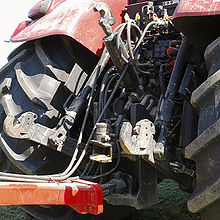Catch hook (agricultural engineering)

In agricultural engineering , a catch hook is a steel component of the three-point hydraulic system ("rear linkage" or "front linkage") of many tractors and some other commercial vehicles. The curved hooks , also known as quick couplers, have a U-shaped opening with a usually self - locking spring-loaded lock. They are used to couple attachments and are designed to hold a load pressure of a few hundred kilograms to several tons. Their dimensions have been standardized by the ISO 730 standard since the late 1970s .
description
Depending on the manufacturer and requirements, various coupling forms can be attached to the lever ends of three-point hubs. In addition to catch hooks, ball-eye couplings are also common. In modern tractors there are mostly catch hooks on the two lower links, while the central upper link is often equipped with a ball joint. Compared to ball-eye couplings, catch hooks on the lower links enable quick and easy coupling, even by one person. The disadvantage is the slightly higher wear , which can be attributed to the greater clearance due to the shape .
Coupling process
During the coupling process, the stationary attachment is driven under by the tractor with the lower links. The catch hooks are brought into position directly under the coupling counterparts of the device to be coupled. Then the lower links are raised, whereby the weight of the implement then opens the catch hook lock (“pushes open”). Suitable catch balls or catch profiles (balls with catch shells) must be mounted on the device. As soon as the correct position in the catch hook is reached, the lock engages automatically and the connection is closed.
safety
In the event of extreme loads, spring-loaded locking mechanisms of the catch hooks can fail, as a result of which the attachment completely or partially detaches from the tractor, which can lead to considerable material damage and accidents. The locks can therefore also be secured, for example with spring clips. Also welding work in correcting or replacing worn hook may endanger stability.
Individual evidence
- ↑ For example, with front linkage kits for compact tractors, simply constructed catch hooks with manually operated safety bolt locks can be used, cf. Fig. In the Matev operating instructions "Attachments for John Deere 46/4700" ( page no longer available , search in web archives ) Info: The link was automatically marked as defective. Please check the link according to the instructions and then remove this notice. (P. 18).
- ↑ Current: ISO 730: 2009 (Agricultural wheeled tractors - Rear-mounted three-point linkage) ; outdated predecessor sub-standards: ISO 730-1: 1977, ISO 730-1: 1990, ISO 730-1: 1994 and ISO 730-2: 1979 as well as ISO 730-3: 1982
- ↑ a b cf. Dietmar Renfert-Deitermann: Renew lower link hooks: New hooks catch better. ( Page no longer available , search in web archives ) Info: The link was automatically marked as defective. Please check the link according to the instructions and then remove this notice. In: Professional magazine for professional agricultural technology, 10/2007. Landwirtschaftsverlag, Münster. ISSN 0937-1583

